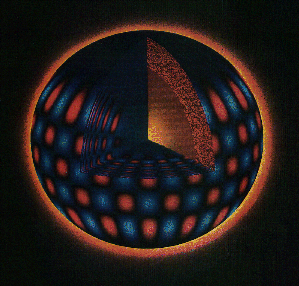
One type of pulsation is shown here. The blue regions are approaching and the red regions are receding from you. The pulsations are thought to extend far into the Sun's interior (courtesy of the National Solar Observatory).
Another probe of the Sun's interior uses the pulsating motions of the Sun. The pulsations are too small to be seen just by looking at the Sun. But the pulsations can be seen if the doppler shifts are measured across the face of the Sun. Some parts of the Sun expand towards the Earth and adjacent regions contract away from the Earth. These regions are several thousands of kilometers across and the pulsation periods are just a few minutes long. Different types of oscillating waves combine to produce the complicated patterns of pulsation seen.

If you disentangle the different oscillation modes from each other, you can use these waves to probe the solar interior. How those waves propagate through the Sun and interact with each other depends on the temperature, density, and composition of the material they pass through. By observing the effects of these waves on the photosphere of the Sun, you can determine the temperature, pressure, density, and composition of the different layers inside the Sun. Geologists on the Earth use similar techniques to study the interior of our planet from earthquake waves in the research field called seismology. Modifying the name for solar studies, the study of the Sun's interior using the solar oscillations is called helioseismology.
Solar astronomers have set up a global network of stations to continuously monitor the Sun's pulsations. This network is called the Global Oscillations Network Group (GONG). Links to web sites describing GONG and other helioseismology sites are given below. Instruments to detect solar oscillations have also been placed on satellites. Check the links below for more information about them.
We can apply the same techniques of helioseismology to the pulsations of other stars. Asteroseismology is the study of the internal structure of stars from their pulsations. We can determine the temperature, pressure, density, and composition of the different layers inside the stars from very careful measurements of minute brightness changes (microvariability) of the stars. From the ground, these pulsations can be seen for only a few brighter stars because of the distorting effects of the Earth's atmosphere. In space much more precise observations are possible so asteroseismology can be extended to smaller, very stable stars, including solar-type stars.
The particular oscillation modes seen also depend on the total mass and diameter of the stars. Smaller stars have higher frequency modes and smaller amplitudes. This means, though, that the stars must have greater apparent brightnesses (smaller apparent magnitudes) than larger stars such as red giants to pick out the microvariability above the statistical noise fluctuations inherent in any measurement. Even still, many thousands of stable, smaller stars lie within the stringent photometric limits required for asteroseismology using space telescopes such as COROT, Kepler, and MOST (alternate link). Asteroseismology provides another way of measuring the overall masses and diameters of stars in addition to the classical techniques described in the previous chapter. With the hundreds of eclipsing binaries discovered by the Kepler mission, asteroseismology predictions can be cross-checked extremely well with the classical techniques using eclipsing binaries.
A bonus feature of asteroseismology is that it enables us to determine the ages of stars as well. As described in the next chapter, the interior structure of a star changes in predictable ways as the stars ages. We can use the stellar evolution models to pick out the density, temperature, and mass of stars at particular ages that match the observed parameters derived from their oscillation modes to get the age of the star.
![]() Go back to previous section --
Go back to previous section --
![]() Go to next section
Go to next section
last updated: December 27, 2018